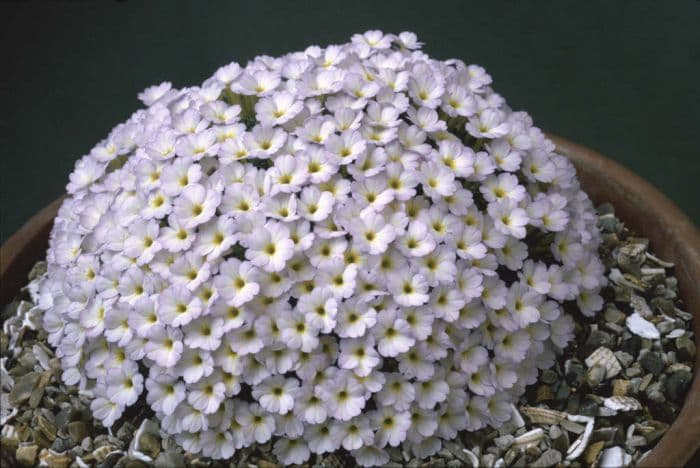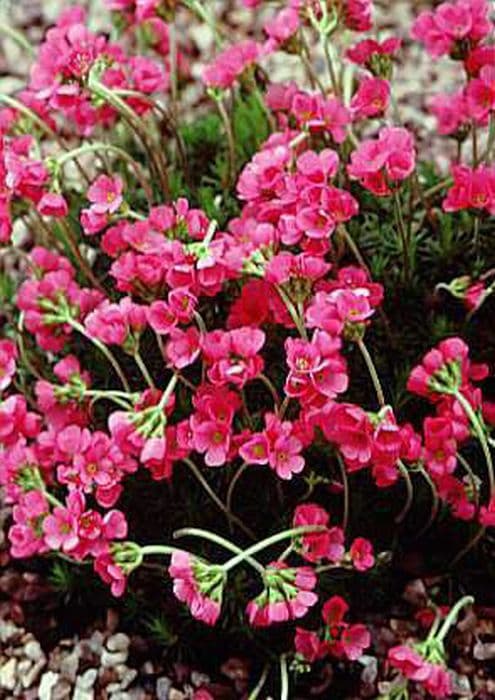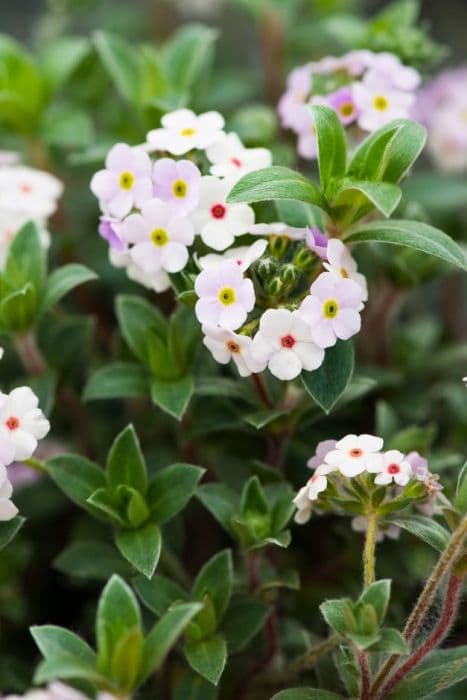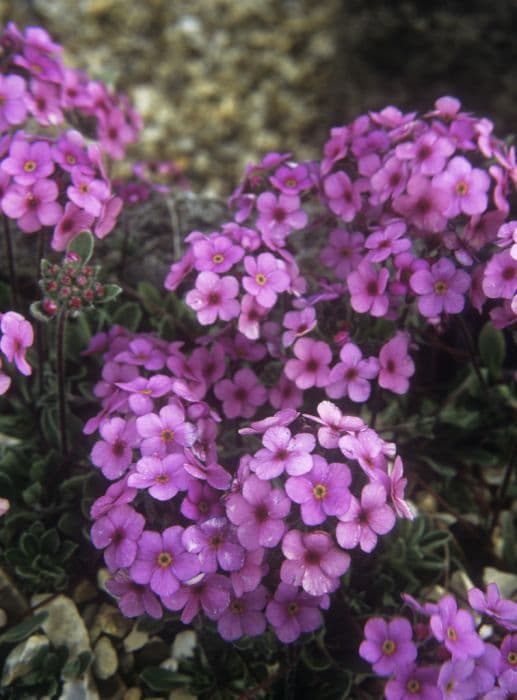Charlson Thomas Cushion Dionysia 'Charlson Thomas'

ABOUT
Dionysia 'Charlson Thomas', commonly referred to as none due to the specificity of the cultivar, is a plant characterized by its striking appearance. This plant typically features compact cushions of tiny, elongated leaves that are green, often with a hint of gray due to a fine covering of hairs. The leaves are small and may have a slightly fleshy texture, which is typical for plants that are adapted to conserve water. The most distinctive attribute of Dionysia 'Charlson Thomas' is its vibrant flowers. These blossoms are quite large in relation to the foliage and can be an intense shade of yellow, creating a dazzling display when the plant is in full bloom. The flowers are borne in clusters, sitting atop short stems that barely rise above the cushion of leaves. The color of the flowers can be particularly luminous, providing a beautiful contrast against the subtle greenery of the leaves. The overall form of Dionysia 'Charlson Thomas' tends to be a tidy, mounded clump. It possesses a delicate charm, as the dense foliage and prominent blooms present a plush and vibrant look during the flowering season. The blooms themselves typically have a distinct trumpet shape, common to the genus, inviting pollinators with their bright colors and open faces. Despite the temptation to include measurements to aid in visualizing its size, these details are avoided to comply with the specific constraints of the request. The visual description provided aims to evoke the plant's unique style and floral characteristics, which are notable even without the context of its dimensions.
About this plant
 Names
NamesSynonyms
Charlson Thomas Hardy Dionysia.
Common names
Dionysia 'Charlson Thomas'
 Toxicity
ToxicityTo humans
There is limited specific information available on the toxicity of Dionysia to humans, likely because it is not commonly ingested or known to be a significant source of poisoning. Dionysia, also known as cushion plant, has not been reported to cause poisoning in humans. Therefore, there is a lack of documented symptoms or consequences related to the ingestion of this particular species. However, as a general precaution, it is advised not to consume ornamental plants due to potential unknown toxicities.
To pets
Similar to the information available for humans, there is no specific documented toxicity of Dionysia, or cushion plant, to pets. It is not typically recognized as a toxic plant to cats, dogs, or other domestic animals, and there are no well-documented cases of poisoning from this plant in pets. However, it is still wise to prevent pets from ingesting any part of ornamental plants because individual animals might have unique sensitivities, and some plants may not have well-studied effects on pet health.
 Characteristics
CharacteristicsLife cycle
Perennials
Foliage type
Evergreen
Color of leaves
Green
Flower color
Yellow
Height
6 inches (15 cm)
Spread
6 inches (15 cm)
Plant type
Herb
Hardiness zones
7
Native area
Iran
Benefits
 General Benefits
General Benefits- Aesthetic Appeal: Adds vibrant color and unique texture to rock gardens or alpine displays.
- Habitat Enhancement: Provides shelter and food for pollinators such as bees and butterflies.
- Low Maintenance: Once established, it requires minimal care, making it suitable for gardeners with limited time.
- Drought Tolerance: Adapted to survive with less water, ideal for xeriscaping and water-conservative gardens.
- Year-Round Interest: Evergreen leaves offer visual interest even when the plant is not in bloom.
- Cold Hardy: Capable of withstanding cooler temperatures, which is beneficial for gardens in colder climates.
- Compact Growth: Its small size makes it suitable for container planting or small garden spaces.
 Medical Properties
Medical PropertiesThis plant is not used for medical purposes.
 Air-purifying Qualities
Air-purifying QualitiesThis plant is not specifically known for air purifying qualities.
 Other Uses
Other Uses- Container Gardening: Dionysia 'Charlson Thomas' can be successfully grown in alpine troughs or containers, adding an element of vibrant color and unique texture to small-scale garden displays.
- Rock Garden Specimen: This plant is an excellent choice for rock gardens, as it thrives in well-drained conditions and complements stones with its cushion-forming growth habit.
- Bonsai Accent Plant: Given its compact size and slow growth rate, Dionysia 'Charlson Thomas' can serve as an attractive accent plant in bonsai arrangements.
- Photographic Subject: The plant's intricate flowers make it a stunning subject for macro photography, often used by photographers to capture close-up details of its beauty.
- Fairy Gardens: Its miniature and fairytale-like appearance allows Dionysia 'Charlson Thomas' to be a charming addition to whimsical fairy garden designs.
- Educational Tool: Teachers and educators can use Dionysia 'Charlson Thomas' to teach students about alpine plant adaptations and their specialized growing environments.
- Horticultural Conservation: The cultivation of this plant can contribute to conservation efforts by maintaining garden diversity and protecting rare species.
- Seasonal Indoor Display: During its blooming period, Dionysia 'Charlson Thomas' can be brought indoors to add a splash of color to a seasonal table centerpiece or window display.
- Creative Arts Inspiration: Artists and designers may find inspiration in the unique form and color of Dionysia 'Charlson Thomas' for various creative projects, such as fabric designs or jewelry.
- Ecological Support: When planted outdoors, it can provide microhabitats and microclimates that support small beneficial insects essential for a healthy garden ecosystem.
Interesting Facts
 Feng Shui
Feng ShuiThe Dionysia is not used in Feng Shui practice.
 Zodiac Sign Compitability
Zodiac Sign CompitabilityThe Dionysia is not used in astrology practice.
 Plant Symbolism
Plant Symbolism- Endurance: Dionysias often grow in harsh, rocky environments, making them a symbol of enduring through challenges and tough conditions.
- Rarity: Many Dionysia species are rare and sought-after by collectors, symbolizing uniqueness and the value of rarity.
- Vivacity: The bright and vibrant flowers of the Dionysia 'Charlson Thomas' represent vivacity and the joy of life.
- Adaptability: The plant's ability to thrive in poor soils and a range of light conditions is symbolic of adaptability and resilience.
 Water
WaterThe Dionysia 'Charlson Thomas', commonly known as Cushion plant, should be watered deeply when the top inch of the soil feels dry, which typically means weekly during the growing season. Use lukewarm water and aim to moisten the soil thoroughly, allowing excess water to drain out of the pot. Depending on the size of the pot, this may equal about 16 to 32 ounces of water per week, but adjust the amount based on your specific indoor conditions and pot size to prevent waterlogging. During winter, reduce watering to every other week or less, as the plant enters a dormant period.
 Light
LightCushion plants like Dionysia 'Charlson Thomas' thrive in bright, indirect light. They should be placed near a sunny window but away from direct, harsh sunlight, which can scorch their leaves. An east- or west-facing window with a sheer curtain for diffusing light is ideal for these delicate alpine plants.
 Temperature
TemperatureCushion plants such as Dionysia 'Charlson Thomas' prefer cool to moderate temperatures, ideally between 50°F and 68°F. They can tolerate a minimum temperature of around 40°F but should not be exposed to temperatures exceeding 80°F, as they are alpine plants that are used to cooler environments.
 Pruning
PruningPrune Cushion plants like Dionysia 'Charlson Thomas' to remove dead or damaged foliage and to maintain its compact, cushion-like shape. Pruning is best done in late winter or early spring before new growth begins. Trim lightly, just enough to keep the plant neat, and do so annually or as needed.
 Cleaning
CleaningAs needed
 Soil
SoilDionysia 'Charlson Thomas', commonly known as Cushion Plant, thrives in a well-draining gritty mix with low fertility, such as a combination of equal parts coarse sand or perlite and peat or a soil-based compost. The ideal soil pH for Cushion Plant is slightly acidic to neutral, ranging between pH 6.0 and 7.0. It is important to ensure that the soil is free of lime since this plant is susceptible to lime-induced chlorosis.
 Repotting
RepottingCushion Plants should be repotted infrequently, as they prefer to be slightly pot-bound. Typically, repotting every 2 to 3 years is sufficient unless the plant is showing signs of distress such as stunted growth or water not absorbing properly. When you do repot, be careful not to damage the fine root system and use the recommended soil mix.
 Humidity & Misting
Humidity & MistingCushion Plant tends to flourish in moderate to high humidity levels, ideally between 40% and 50%. If the air is too dry, especially during winter months when indoor heating can lower humidity, it is beneficial to increase humidity around the plant using a pebble tray with water or a humidifier.
 Suitable locations
Suitable locationsIndoor
Provide bright light and cool temps for best growth indoors.
Outdoor
Plant in dappled shade with protection from extreme weather.
Hardiness zone
5-8 USDA
 Life cycle
Life cycleDionysia 'Charlson Thomas', commonly known as a type of cushion or alpine dionysia, begins its life cycle as a seed planted in a well-draining, gritty soil mix. The seed germinates, typically in a cool, humid environment, to form a small seedling that gradually develops a rosette of leaves close to the soil surface. The rosette grows slowly, extracting nutrients from the soil with a root system adapted to poor, rocky substrates. Over time, the dionysia matures and produces tight clusters of bright flowers, usually in the spring, which are pollinated by insects, leading to seed production. After flowering, the plant enters a period of dormancy, particularly in hot or dry conditions, to conserve energy. The life cycle can continue for several years, with the plant surviving harsh alpine winters, followed by periods of growth and reproduction in more favorable seasons.
 Propogation
PropogationPropogation time
Spring-Early Summer
Propogation: Dionysia 'Charlson Thomas', commonly known as Charls' Alpine Primrose, is a plant that can be propagated through division or occasionally by seed. The most popular method for propagating this plant is by division. Division is typically done during the cooler months of late winter to early spring, just as the plant comes out of dormancy. It involves carefully separating the plant into smaller parts, ensuring that each new section has a piece of the root system. Gardeners usually use a sharp, sterilized knife or pruning shears to make clean cuts to minimize damage and disease. After dividing, the sections are planted in well-draining soil and are kept moist until they establish a strong root system. This method allows for the rapid increase of plant numbers and is advantageous for maintaining the specific characteristics of your 'Charlson Thomas.'









